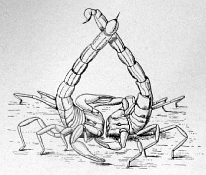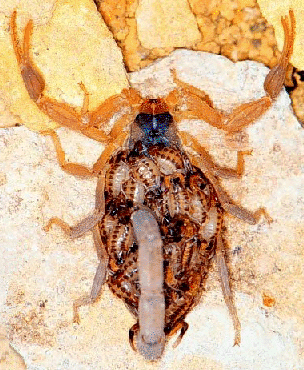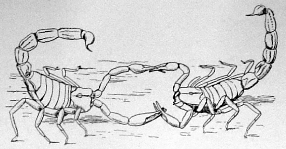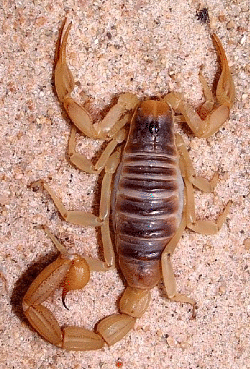
Consulting Entomologist

Tel/Fax: 01275 854224
E-Mail: [email protected]
Site Guide
Site Search
Home Page
Career Page
Insect Files
- Contents
- Bug Index
- The World of Bugs
- Classification of Bugs
- Insect Identification
- Insect Fossils
- Insect Body-parts
- Micro View of Bugs
- Insect Life Cycles
- Insect Defences
- Insects of Nailsea
- Pesticide Safety
- Bibliography
Shortcut to the main groups of insects and other arthropods...
Bug Rhymes & Poems
Links
Shop
Payments (credit/debit card)
Scorpions |
Class: Arachnida Order: Scorpionidea |
| A bit of a sting in the tail . . . . . . | |
|
|
True scorpions range in size from small species little more than 15 mm long, to the giants of the arachnid world measuring 20 cm or more in length. However, all are fairly uniform in their general appearance and are so well known to most people that there is probably little or no difficulty in their general recognition. The North American desert scorpion shown opposite is a typical example. Scorpions, like other arachnids, have two main body regions - a front part called the cephalothorax (or prosoma) and a hind part called the abdomen (or opisthosoma). The cephalothorax forms a hard carapace which bears the usual arachnid appendages - chelicerae (jaws), a pair of palps and four pairs of walking legs. The palps are always greatly enlarged, with the terminal segments modified into strong pincers used for catching and crushing prey. Near the middle of the carapace are two simple eyes, and on the side borders near the front there are usually groups of smaller eyes. Behind and broadly attached to the carapace is the segmented abdomen, consisting of six broad segments (called the mesosoma) and several narrower segments (called the metasoma) which form the 'tail'. The last segment of the 'tail' (known as the post-anal segment or telson) is modified into a characteristic, more or less globular poison sac which terminates in the fine, curved spine of the scorpion's sting. Scorpions breath through paired openings (called stigmata) situated on the underside of each of the last four broad segments of the abdominal mesosoma. These openings allow air to enter and leave the internal lung-sacs. Also on the underside, but on the second abdominal segment in front of the stigmata, are a pair of comb-like organs, called pectines, which appear to have a tactile function. |
|
Scorpions are found mainly in arid regions of the tropics and sub-tropics. They are nocturnal and during the day they hide away under stones or logs, in holes or crevices in the ground, or in pits which they excavate in the soil or sand. All are predaceous, feeding for the most part on insects, spiders and other small invertebrates. Prey is seized by the pincers, and if fairly small it is merely crushed and chewed using the chelicerae (jaws), but when a larger animal is captured the poisonous tail-sting may be used to quickly subdue and paralyse the prey before it is eaten. Despite having several eyes, scorpions can only perceive moving objects within a range of a few centimetres. Their most well developed sense is that of touch, which largely seems to reside in the many hairs that cover the appendages and body. The pectines on the underside of the abdomen are special tactile organs which may be used for detecting food and probably have a role in sex recognition since their structure often differs between males and females. Fabre (1907) gives a fascinating account of the curious and elaborate mating behaviour of scorpions from observations on a southern European species, Buthus occitans. He noted that in male and female encounters, the two scorpions initially stood face to face with raised tails which they intertwined. The male, using his pincers, would then grasp the pincers of the female and proceed to walk backwards with the female following. This courtship dance, the two animals 'hand-in-hand' so to speak, lasted an hour or more, during which time the scorpions turned and circled several times (see sketches below, adapted from Fabre). Then, whilst still holding the female and when in the neighbourhood of a suitable stone, the male would excavate a nuptial chamber into which both scorpions retreated. Fabre also noted that after mating, male scorpions were often devoured by the females. This kind of post-coital cannibalism - the male being eaten by the female after mating - is by no means confined to scorpions. Similar cannibalistic behaviour is known amongst spiders and in a few insect carnivores such as praying mantids. Mating is clearly a precarious business for the males of these predatory arthropods, and interestingly, like male scorpions, the males of many spiders, and perhaps to a lesser degree those of some mantids, also indulge in elaborate courtship rituals as a preamble to mating - no doubt to ensure that they are recognised by the female as a potential mating partner and not immediately attacked and eaten by her as potential prey, at least not before mating has occurred. However, once mating has been accomplished, whether a male is then eaten by the female, or manages to escapes unharmed, is perhaps just a question of chance and may be relatively unimportant, since in either case the courtship ritual apparently enables the male to better survive his initial encounter with a female, mate successfully and hence pass his genes onto the next generation, which may be all that matters in the longer-term processes of natural selection and evolution. | |
 Courtship approach with tails raised & intertwined Adapted from Fabre (1907) |
 Female scorpion with young on its back Photo: J. Kalisch - UNL © | ||
 Courtship dance 'hand-in-hand' Adapted from Fabre (1907) |
|||
|
All scorpions are viviparous (i.e., the eggs develop and hatch inside the mother) and at birth the live young resemble adults apart from their much smaller size. The newly-born young are carried about on the back of the mother and protected by her (see picture above), so even these fearsome arachnids show some degree of parental care! The young usually remain with the mother until after their first moult, and then separate from her to lead their independent lives. It may take several years from birth before scorpions reach their full size and maturity. As is the case with most poisonous animals, the ferocity of scorpions has been much exagerated and they rarely sting unless molested or touched accidentally. Their usual response when disturbed, especially during the day, is to scurry away and seek shelter. Nevertheless, most species are highly poisonous and their sting extremely painful, and the sting of some of the larger species can prove fatal to humans. Scorpions themselves are apparently immune to their own poison and more or less immune to that of closely allied species. More pictures of scorpions (and other arachnids) at the Department of Entomology, University of Nebraska-Lincoln (UNL). | |||
References
|
|
RELATED PAGES (Other Arachnida) | ||||
|
FALSE SCORPIONS (Pseudoscorpiones) |
KING CRABS (Xiphosura) |
WHIP SCORPIONS (Pedipalpi) | ||
|
HARVESTMEN (Opiliones) |
MITES (Acari) |
WIND SCORPIONS (Solifuga) |
SPIDERS (Araneae) | |
 (classification of arachnids) |
| <<< TOP | (use the back button on your web browser to return to the previous page) | TOP >>> |
